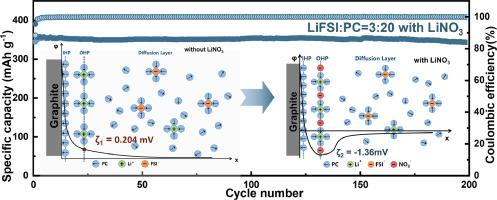当前位置:
X-MOL 学术
›
Energy Storage Mater.
›
论文详情
Our official English website, www.x-mol.net, welcomes your
feedback! (Note: you will need to create a separate account there.)
Outer Helmholtz plane adsorption regulation to achieve low-concentration of pure propylene carbonate solvent electrolytes compatible with graphite anode
Energy Storage Materials ( IF 18.9 ) Pub Date : 2024-11-04 , DOI: 10.1016/j.ensm.2024.103885 Jiaming Jiang, Yuliang Cao, Fei Xu
Energy Storage Materials ( IF 18.9 ) Pub Date : 2024-11-04 , DOI: 10.1016/j.ensm.2024.103885 Jiaming Jiang, Yuliang Cao, Fei Xu

|
The low melting point and high polarity of propylene carbonate (PC) make it an ideal solvent for electrolytes of lithium-ion batteries (LIBs), but the incompatibility with graphite anode hinders the application. In the present study, a new method is developed to solve this problem from a new viewpoint. Introduction of saturated LiNO3 (0.14 mol L‒1 ) into pure PC electrolyte containing lithium salt with normal concentration (1.38 mol L‒1 ) leads to a perfect compatibility with graphite anode. Li/Graphite cell using this pure PC electrolyte shows a reversible capacity of 350.0 mAh g‒1 and a 200-cycle capacity retention of 96.3 %. Further mechanism study and theoretical computation indicate that the NO3 ‒ anions are adsorbed to outer Helmholtz plane of the electric double layer at the graphite anode interface. This changes the Li+ solvation structure in the electric double layer, facilitating the Li+ desolvation process hence resulting in high compatibility with the graphite anode. The most prominent advantage of the present strategy is that, because of the adsorption of NO3 ‒ anions to the outer Helmholtz plane, the compatibility with graphite anode could be improved by introduction of tiny amount of Li salt without large change of the bulk phase properties of the electrolyte. This work provides a new understanding of the compatibility from the viewpoint of outer Helmholtz plane, which might deliver new insights for the optimization of electrolytes for LIBs.
中文翻译:

外部亥姆霍兹平面吸附调节,实现与石墨负极相容的低浓度纯碳酸丙烯酯溶剂电解质
碳酸丙烯酯 (PC) 的低熔点和高极性使其成为锂离子电池 (LIB) 电解质的理想溶剂,但与石墨负极的不相容性阻碍了该应用。在本研究中,开发了一种从新角度解决这个问题的新方法。将饱和 LiNO3 (0.14 mol L\u20121) 引入含有正常浓度 (1.38 mol L\u20121) 锂盐的纯 PC 电解质中,可与石墨阳极完美相容。使用这种纯 PC 电解质的锂/石墨电池显示出 350.0 mAh g\u20121 的可逆容量和 96.3% 的 200 次循环容量保持率。进一步的机理研究和理论计算表明,NO3\u2012 阴离子在石墨阳极界面处被吸附到双电层的外亥姆霍兹平面上。这改变了双电层中的 Li+ 溶剂化结构,促进了 Li+ 脱溶剂化过程,从而与石墨负极具有高度相容性。该策略最突出的优点是,由于NO3\u2012阴离子吸附到亥姆霍兹外平面上,通过引入微量的锂盐可以提高与石墨负极的相容性,而不会使电解质的体相性质发生很大变化。这项工作从外亥姆霍兹平面的角度为兼容性提供了新的理解,这可能为 LIB 电解质的优化提供新的见解。
更新日期:2024-11-04
中文翻译:

外部亥姆霍兹平面吸附调节,实现与石墨负极相容的低浓度纯碳酸丙烯酯溶剂电解质
碳酸丙烯酯 (PC) 的低熔点和高极性使其成为锂离子电池 (LIB) 电解质的理想溶剂,但与石墨负极的不相容性阻碍了该应用。在本研究中,开发了一种从新角度解决这个问题的新方法。将饱和 LiNO3 (0.14 mol L\u20121) 引入含有正常浓度 (1.38 mol L\u20121) 锂盐的纯 PC 电解质中,可与石墨阳极完美相容。使用这种纯 PC 电解质的锂/石墨电池显示出 350.0 mAh g\u20121 的可逆容量和 96.3% 的 200 次循环容量保持率。进一步的机理研究和理论计算表明,NO3\u2012 阴离子在石墨阳极界面处被吸附到双电层的外亥姆霍兹平面上。这改变了双电层中的 Li+ 溶剂化结构,促进了 Li+ 脱溶剂化过程,从而与石墨负极具有高度相容性。该策略最突出的优点是,由于NO3\u2012阴离子吸附到亥姆霍兹外平面上,通过引入微量的锂盐可以提高与石墨负极的相容性,而不会使电解质的体相性质发生很大变化。这项工作从外亥姆霍兹平面的角度为兼容性提供了新的理解,这可能为 LIB 电解质的优化提供新的见解。


















































 京公网安备 11010802027423号
京公网安备 11010802027423号